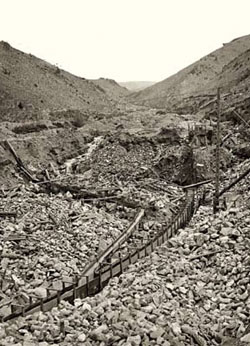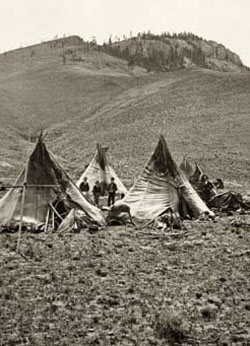Montana: Stories of the Land
Companion Website and Online Teacher's Guide
Chapter 6 - Montana's Gold and Silver Boom, 1862-1893
Chapter 1 - Montana: Where the Land Writes History
Chapter 2 - People of the Dog Days
Chapter 3 - From Dog Days to Horse Warriors
Chapter 4 - Newcomers Explore the Region
Chapter 5 - Beaver, Bison, and Black Robes
Chapter 6 - Montana's Gold and Silver Boom
Chapter 7 - Two Worlds Collide
Chapter 8 - Livestock and the Open Range
Chapter 9 - Railroads Link Montana to the Nation
Chapter 10 - Politics and the Copper Kings
Chapter 11 - The Early Reservation Years
Chapter 12 - Logging in the "High Lonesome"
Chapter 13 - Homesteading This Dry Land
Chapter 14 - Towns Have Lives, Too
Chapter 15 - Progressive Montana
Chapter 16 - Montana and World War I
Chapter 17 - Montanans on the Move
Chapter 18 - The Great Depression Transforms Montana
Chapter 19 - World War II in Montana
Chapter 20 - Building a New Montana
Chapter 21 - A People's Constitution
Chapter 22 - Living in a New Montana
Learning From Historical Documents
Letter from Cornelius Hedges to "Parents," from Helena, September 13, 1865. Cornelius Hedges papers, 1831-1907. Manuscript Collection 33. [box 1 folder 33]. Montana Historical Society Research Center. Archives. Excerpted in Not In Precious Metals Alone: A Manuscript History of Montana (Helena, 1976): 49.
Context for Cornelius Hedges's Letter:
Most of Montana's mining communities flourished briefly, only to die when the placer diggings played out. In the few that survived, notably Helena, Butte, and Virginia City, violence gradually gave way to law and order, and a sense of community and permanence emerged. Many who had arrived in Montana expecting to make their fortune and quickly depart found that the new land grew on them. One of those who decided to cast his lot with Montana was Cornelius Hedges, a Yale and Harvard Law School graduate who arrived in Helena in July 1864. After a year working for day wages and giving only intermittent attention to his law practice, Hedges determined to remain in Montana one more year. Then, regardless of his prosperity, he planned to return home. During that year Hedges realized that new opportunities lay in the territory's developing economy, and although he did return home in 1866, his intention was to escort his family back to Montana to make a permanent home.
-
See historic photos while listening to someone read the excerpt.
-
Complete a Written Document Analysis Worksheet.
About Primary Sources:
Letters, diary entries, census records, newspapers, and photographs are all examples of "primary sources," material created at a particular moment in the past that has survived into the present. Primary sources can provide clues to the past. They are our windows into an earlier time. The Montana Historical Society contains thousands of primary sources. In the 1970s, archivists collected just a few snippets into a book, which they called Not in Precious Metals Alone: A Manuscript History of Montana. That book is now on the web in its entirety. The above sample from that book relates directly to this chapter.


